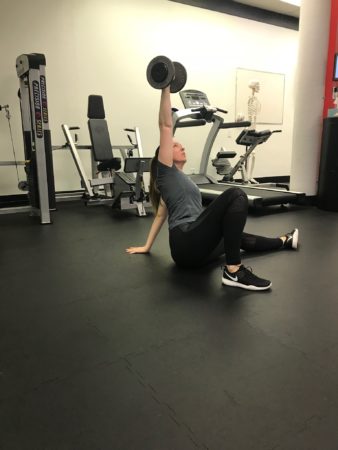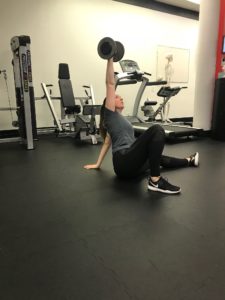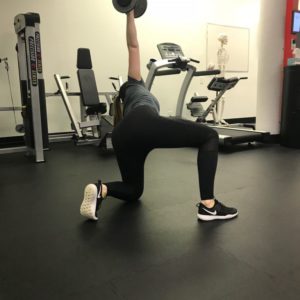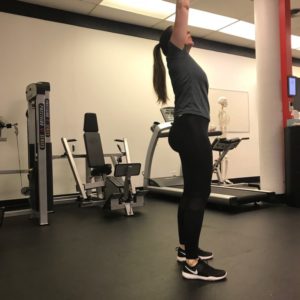The Turkish Get Up – An Often Forgotten Powerhouse Exercise
The Turkish Get Up
 The Turkish Get Up (TGU) is a multiple movements woven together into a powerhouse exercise that incorporates three planes of motion. Holding the weight (dumbbell or kettlebell) overhead challenges the core, which must be engaged throughout the entire pattern.
The Turkish Get Up (TGU) is a multiple movements woven together into a powerhouse exercise that incorporates three planes of motion. Holding the weight (dumbbell or kettlebell) overhead challenges the core, which must be engaged throughout the entire pattern.
The Turkish Get Up is an excellent way to build strength, stability, balance, kinesthetic awareness and overall coordination. The Turkish Get Up has a wide variety of benefits including upper and lower body stability, stimulates the vestibular system, closed and open chain shoulder stability, thoracic extension and rotation, encourages the proprioception system, makes the upper and lower extremities work reciprocally, promotes stability in two different leg patterns, incorporates hip and leg mobility and active flexibility, and it develops upper body strength, trunks strength, and hip strength.
Technique is the Key
No matter what type of resistance equipment you choose (Dumbbell, Kettlebell or Sandbag), you will get an incredible workout as this exercise works most of the muscle groups of your body.
Having the arm continuously stretched overhead holding the weight makes it an excellent exercise for shoulder stability which will help develop strength with other exercises such as the bench press or military press.
The TGU develops the core muscles effectively since tight abs and strict control are required through the entire movement.
You should have a personal trainer go through the movement pattern with you if this is a new exercise being added into your routine. It’s very complex and can lead to injury if done incorrectly. Make sure you learn each step individually before trying to do the entire pattern. Start by practicing one or two movements at a time before adding in another one. Don’t rush through this exercise, it’s all about technique!
There are a lot of tutorials online, but we are including a video by one of our elite personal trainers that will help you to understand the steps from the start position on the ground to standing up and going back to the starting position.
Turkish Get Up
Sets: 2-4 sets
Reps: 8 -12
Instructions:
 1) Start Position
1) Start Position
Lie on your back with your shoulder blades down and back (packed). Begin with the
weight in your right hand, your right knee should be flexed with your heel near your butt, and the left leg should be straight and slightly abducted (angled away from your body). Think about lengthening through your left heel to turn on your core turned-on. This is the starting position.
 2) Go-to-the-the Elbow
2) Go-to-the-the Elbow
Slide up into a crunch position but place your left elbow on the ground while punching the right hand up to the ceiling with the weight.
As you crunch and punch, drive through your right heel and lengthening through your left heel.
Lift through the chest as you crunch. You don’t want your chest to cave in. Instead, think about keeping the chest up and out or stay in a good thoracic spine extension.
 3) Go-to-the-Hand
3) Go-to-the-Hand
Shift your weight from your left elbow to your left hand. Make sure your right hand is towards the ceiling and you keep your right shoulder packed and close to your body, maintain your chest up and out
4) Hip Extension- Glute Bridge
From the seated position with your left hand on the floor, actively drive through your right heel into a bridge. Make sure you are extending through the right hip instead of arching your lower back (lumbar spine extension) and firmly contract your right glute. Maintaining your chest up and out from the start of the lift should help. 5) Sweep the Left Leg
5) Sweep the Left Leg
From the hip extension position, sweep your left leg back and position your left knee on the ground underneath your body. It is really important to keep a neutral lumbar spine to reduce the risk of injury. Keep your chest up and out and your lower back as flat as possible (think about lengthening your spine).
6) Up-to-Kneeling Position
From the previous position, rotate your left leg so it’s straight and in-line with your body, and straighten your torso so you’re upright in a tall body position (elongate your spine, crown of the head to the ceiling and chin neutral).
Once you’re in this position, make sure that everything else is properly aligned I.E.: chest is up, spine is extended, shoulder is packed, hips are neutral and eyes are forward.
Your eyes should be on the weight throughout most of the movement pattern. This will be the first time where you’ll take your eyes from being focused on the weight to focusing straight ahead.
 7) Stand-up
7) Stand-up
From the kneeling position do a split squat to stand-up. Make sure you stay tall, drive through your heel, and stand-up to a point where your feet are next to each other.
8) Getting Back Down – Reverse Lunge
Now you are going to start your descent back to the starting position by reversing the pattern. From the standing position with your right arm overhead, take a large step backwards with your left leg, flex your left knee (bend) slowly and using great control until your left knee is on the ground. Make sure you are maintaining an elongated spine, stay tight through your midsection, and keep your shoulder packed (down and back).
9) Hand-to-the-Ground with Leg Rotation
Once you’re set-up in the half-kneeling position, it’s time to start dropping down to the ground. Begin by lifting your eyes up to the weight, place your left hand on the floor while you are doing a windshield wiper motion with your left lower leg to get it back into position (rotate your left heel toward your right leg).
Make sure you lengthen your spine and drive your right hip into full extension. When done correctly you should be able to maintain a fairly neutral spine. People with tight hips should feel a significant stretch in the right hip as they extend.
10) Sweep the Leg Back Through
When you are transitioning, back sweep the leg through and extend the left leg driving through the left heel. On the transition back, it will be difficult and awkward to maintain as high of a glute bridge. Instead, focus on a lower bridge while sweeping the leg through.
11) Hand-to-Elbow
As you transition from the hips extended and legs straight, simply drop your hips back down to the ground slowly and with control, keeping the glutes tight. Keep your right shoulder down and back, the shoulder blade packed and the thoracic spine (t-spine) extended with the chest up and out. Once the butt hits the ground slowly start to flex the left elbow and gently place the elbow and forearm on the ground.
12) Rolling Back to Start
It’s very important to stay in control as you roll back into position with the right shoulder packed, t-spine extended and your right arm still pointing up to the ceiling. Use your abdominals to help you roll back down to the ground into a supine position (face-up) with the right knee flexed and the left leg extended and abducted. Control is the name of the game for this important exercise.
Infofit recommends that anyone new to exercise should hire a certified personal trainer. A qualified elite personal trainer can save you a lot of wasted time by teaching you how to train safely and effectively the first time.
Infofit also recommends that anyone between the ages of 15 and 69 years of age, should fill out a Par-Q (Physical Activity Readiness Questionnaire ) which will tell you if you should check with your doctor before starting. Anyone over the age of 69 should still fill out the form, however, if you are not used to being very active, check with your doctor before starting any exercise program.
Sherry is a Certified Personal Trainer who graduated with her ACE Certificate from Infofit’s Full-Time Program in April 2015. Sherry is co-owner of Primal PT. Sherry began her career in Health Care as an Administrative Assistant and Secretary. Working in the Healthcare Industry grew her passion for health and fitness and allowed her to re-join this working community in a preventative role.
Happy Training!
Cathie Glennon- BCRPA/SFL, Clinical Exercise Specialist

